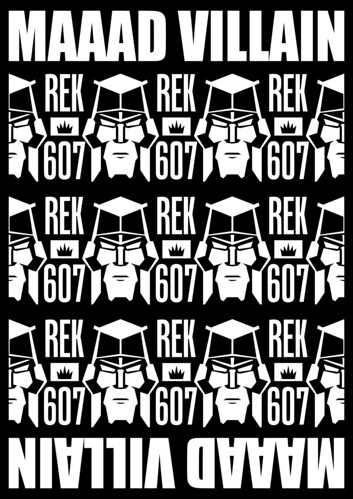25.6.13
23.6.13
21.6.13
MAAAD VILLAIN
Poster for the trip to Brighton and London this summer, representing International Sticker Crew and Asses and Tits.
11.6.13
Re-Writing the Streets: The International Language of Stickers
Re-Writing the Streets: The International Language of Stickers
A Traveling Exhibition
Curated by Catherine Tedford and Oliver Baudach
Overview
In the last twenty years, street art has evolved dramatically from the graffiti that peppered subway stations, back alleys, and train yards, and was typically seen as vandalism. Today, new forms of visual communication are created in public spaces, often attracting viewers in more contemplative and/or interactive ways. Street art stickers, or simply “stickers,” have emerged as a vehicle for self-expression and an effective way to engage passersby. Stickers may be used to “tag” or claim a space and make it temporarily one’s own, to sell products or services, to announce events, to publicize blogs or other social media sites, or to offer social commentary and political critique. As one of the most democratic art forms, stickers can be created and distributed easily, quickly, and widely, through do-it-yourself drawings, silkscreens, and stencils, or inexpensive online printing companies.
In urban sites typically dominated by commercial advertising and corporate logos, publicly placed stickers, by their very presence, re-write the streets and produce what curator Nato Thompson calls “creative disruptions of every day life.” Sticker artists use a range of rhetorical strategies in their work, from humor and charm to rebellion and resistance. Representing a diverse array of voices and perspectives, stickers offer a spirited “ground up” alternative to an often “top down” media-saturated environment. And although street art stickers are ephemeral by nature, they capture the creative, cultural, and political pulse of time and place.
Description
Drawing the finest examples from two collectors, Oliver Baudach in Germany and Catherine Tedford in the United States, the exhibition includes over 800 original, unused stickers grouped by artists, themes, dates, and geographic locations. Oliver Baudach is the founder and director of Germany’s Berlin-based Hatch Kingdom, the world’s first museum devoted to sticker art. Representing three decades of work and spanning genres from character design artists to skateboarding and street wear, Baudach’s collection numbers over 25,000 stickers from Europe and around the world. With an extensive network of artist contacts, Baudach has become a leading expert in the field. Catherine Tedford, gallery director at St. Lawrence University, Canton, New York, has been collecting stickers since 2003, and her collection numbers over 8,000 stickers from North America and Europe. Her recent focus is on historical political stickers produced in the United States by such organizations as the Industrial Workers of the World during the 1910s and Students for a Democratic Society during the 1960s and ‘70s, as well as Catalonian separatist stickers from Spain during the 1970s and ‘80s, examples of which are all included in the exhibition.
Individual sticker artists and artists’ collaboratives who tag the streets are represented in the exhibition, though rather than using their real names, most artists adopt street names that conceal their true identities. Well-known artists in the exhibition include Cupco (Australia); Hoplouie (Denmark); Flying Fortress, Haevi, Ping Pong, Prost, Tower, and 24/7 Crew (Germany); Bust and Sol Crew (Netherlands); and Evoker, Obey Giant, RobotsWillKill, Zoltron, and 14Bolt (United States). Some artists tag the streets with humanoid figures, robots, animals, insects, eyes, hands, and other imaginative character designs, while other artists play with type fonts and other graphic design elements. Such portraiture and signature stickers are widespread, whereby artists are engaged in tireless self-promotion. Other stickers serve as social commentary and critique, and subjects addressed in the exhibition include animal rights, civil liberties, the economy, environmental issues, identity, music, political protest, and sports.
Contents
- Fifty-two framed sets of stickers grouped by artists, themes, dates, and geographic locations
- A main text panel that provides an overview of the exhibition
- Two co-curators’ statements describing their history and experience with stickers
- Thirty accompanying interpretive text panels with artists’ statements and/or artistic, cultural, and historical contextual analysis.
- A limited edition ‘zine catalogue featuring full-color illustrations and selected artists’ statements; 25 are included with the traveling exhibition, and additional copies can be purchased for $5.00 each.
- Contemporary sticker-related publications, ‘zines, and sticker rolls for display cases and hands-on viewing.
Outreach for Teaching and Research
Re-Writing the Streets: The International Language of Stickers is geared toward college and university audiences in the United States and Canada, though the exhibition will be of interest to a broader public of all ages. The exhibition will introduce sticker art to new audiences; offer those in academic and art circles an exciting and versatile educational resource; and provide wider recognition for an important contemporary artistic movement. A multitude of subjects exist in this field for teaching and research in disciplines ranging from art and art history, communication studies, cultural studies, and global studies to government, modern languages, and sociology.
Subscribe to:
Posts (Atom)


